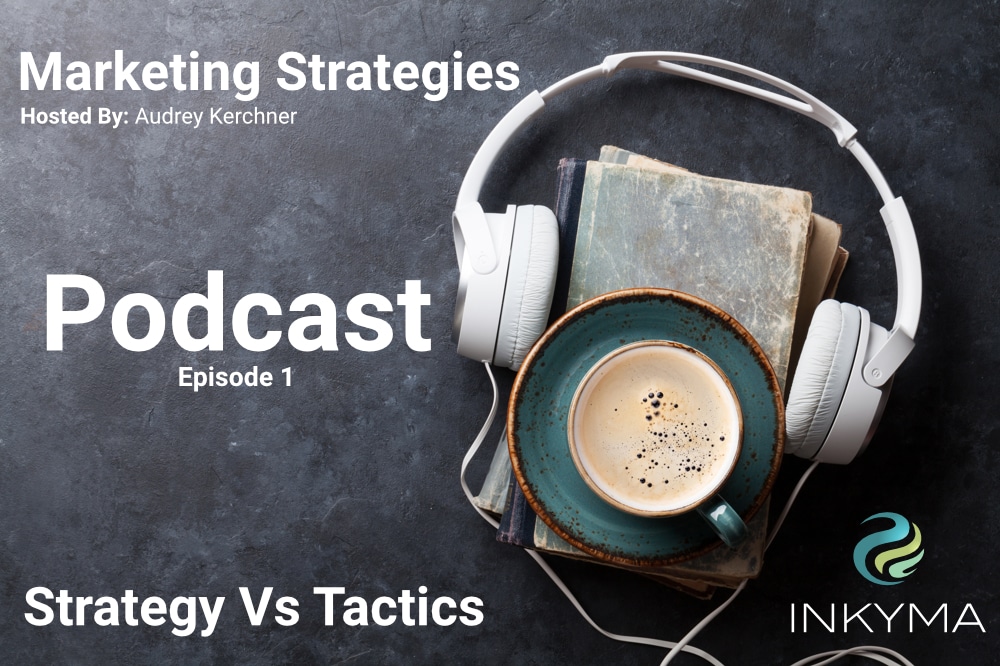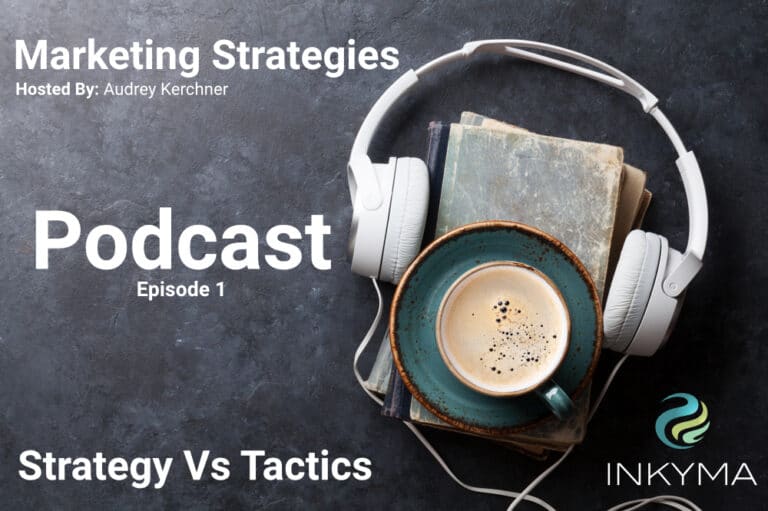
Marketing Strategies Podcast
Episode 1
In this first episode of the podcast, I talk about the difference between marketing strategy vs tactics.
- The difference between marketing strategy and tactics
- The 5 Steps to take to develope a marketing strategy
- The type of tactics you can develope based on your strategy
- The 4 buckets of intent for your tactics
Marketing Strategy Vs Tactics Transcription
Announcer:
Welcome to Marketing Strategies with Audrey Kerchner, sponsored by Inkyma. Take your small business to the next level with proven creative solutions designed to grow your awareness and connect to your customers. Now, here’s Audrey.
Audrey Kerchner:
Welcome to Marketing Strategies. I’m Audrey Kerchner, the co-founder of Inkyma. I wanted to start off by giving you a little bit of my background. I’ve been in marketing for over 20 years. I’ve worked for large Fortune 500 companies like Schering-Plough. They’re the makers of Claritin, Nasonex, Coppertone, and Dr. Scholl’s, you probably know the brands. And then I worked for a marketing agency on Madison Avenue in New York for some time. And the team that I worked with there, one of the big things we did is one of our projects got nominated for a Clio Award, which is the equivalent to the Oscars for the movies. So, we were pretty proud of that. Inkyma is a full-service marketing agency. And so, I took and brought that big agency feel and brought it down to the small business owner. What we do is we do marketing strategy, branding, website design and hosting, content marketing, search engine optimization for our sites, social media, and digital advertising.
Audrey Kerchner:
So, to learn more about what we do, or maybe ask us a question, or even schedule a marketing evaluation, you can go to our website at inkyma.com. That’s I-N-K-Y-M-A.com. To start off our radio and podcast show here, I wanted to talk about marketing strategy and specifically strategy versus tactics. When I’m meeting with a potential client, I always like to ask the question, “What’s your current marketing strategy?” What I usually get is, “Oh, we’re doing digital ads. We’re posting to social channels like Facebook, Instagram, Snapchat, Twitter, LinkedIn, we’re sending some emails out, I go to networking meetings.” Or, “We’ve got this great special promotion that we’re doing.” What I often don’t hear is this, “We are looking to grow the company 10% this year by targeting married women ages 25 to 65 in Colorado Springs to purchase our XYZ widget because that is the most lucrative client and product for us.”
Audrey Kerchner:
So, you can kind of hear the difference between the two. The first one, they’re tactics, those are things that you do in a marketing strategy. The second one is strategy and that’s why you’re doing those things. And if you don’t know why you’re doing those things, you’re just really kind of throwing spitballs against the wall and hoping they stick. And if you take anything away today, I want you to realize that hope is a really bad strategic plan. Because you start with tactics and not a strategy, you really never know if they’re the right tactics done in the right place or if they’re even successful or not because you haven’t created measurable goals. And so, that’s why strategy is so important, taking that time to develop a strategy before you throw tactics out will make those tactics so much more effective. So, I want to talk to you about the five steps that you need to develop a marketing strategy to make it a little easier for you.
Audrey Kerchner:
The first thing you do is you’re going to define your business goals for a specific timeframe. You may not be a year planner, right, your business just may not lend itself well to your planning quarterly, monthly, half a year, you pick your timeframe, and then choose the goal. Most of the time, when people come to me, it’s a growth goal. I want to grow my business in a certain measurement way. And every industry or business is different on how they like to measure, which is totally fine. Awareness, they don’t want to be the best-kept secret in Colorado or wherever they are any longer or when they’re, say their company’s name, people are like, “Oh, what is that?” They don’t want that. Some want to maintain. And I’ve even had a client who came to me with the strategy of figuring out how to close down his business after being in business for over 75 years. He had a lot of inventory and he wanted to not have a fire sale, but sell everything as well as he could kind of with an anniversary vibe before he went out and sold everything.
Audrey Kerchner:
So, I get all sorts of different reasons and goals for why they want to market themselves. The second step is to figure out what your most lucrative product or service is, and then, based on that service, who your primary and perfect customer is. Now, you may sell a bunch of different things but the reason why for a marketing strategy we hone in on those two things is that’s where you’re going to start spending a lot of time and money, and so you want to get the best bang for your buck, from the tactics that you’re doing. An example is, I had a client, they were in food service and they had like eight different offerings. They had a storefront, they did on-site catering, they did pick up catering, they did a food truck, they would go to special events and do all these other things.
Audrey Kerchner:
When she and I spoke, the owner, she was tired of traveling around hauling things and what we realized was that she was making her most money from people coming to her store and picking stuff up and taking it home with them. And so, we devised her whole entire marketing strategy around getting more people into her storefront and less asking for catering. It worked out beautifully for her. She had a lot more time on her hands, she had fewer employees because she didn’t have to put people everywhere. So, that’s why I want you to really think about that first before you decide on any type of tactic. The third step is creating in our industry what we call a customer persona for that perfect customer. And really what it is, is figuring out what they look like, who they are, where they go, and what they buy. That’s what a customer’s persona is.
Audrey Kerchner:
So, you’re going to look at demographics like age, income, education, location, where they are, are they single, are they married, do they have three kids, are their kids teenagers, right? For your service or product, who is the best person to be ready to buy from you? If you’re a B2B or if you tend to have your services lean towards someone who’s a professional, flesh out what those professionals look like. What’s their title? What’s their company size? Who do they report to? What tools and software do they use? These are important because if you’re going to be doing digital advertising, some of these are actually targeted digital attributes that you can actually target them from. For example, let’s say you’re doing health insurance for companies that are 50 employees and under, you’re going to want someone whose target in this range is, they’re the HR company, they’re 50 or fewer employees not more, and that HR director reports to the CFO or the CEO.”
Audrey Kerchner:
So, that’s how you would flesh out that piece of it. The other thing to look at is their personality traits. What are their interests, their hobbies, their favorite brands, what are their values? If your company is a value-based sell, you have to understand what values are important to that person. Other informational sources, their books, magazines that they like, blog posts, podcasts, what YouTube channels do they like, what events do they attend, what associations are they members of, and who are the gurus and the experts that they listen to? Again, when you do targeted marketing, you want to figure out where they’re at so you can put yourself in front of them while they’re there. And knowing these type of things help with that.
Audrey Kerchner:
You want to know their challenges and fears, not just with what your service offers products, but not only for the services and products that you offer but what other challenges do they have? Like, what other problems are you solving? That’s part of that. And then, finally, what are their goals? What do they want from your product or service? That’s really important because if you can tell them that like, “I understand your problem, here’s how I solve it, and here’s how you can sign up,” you’re more likely to get their attention. Moving on to step number four, here’s where, now that you know who they are and really know who they are, you want to figure out how to talk to them in their own language. Talk a little bit about that and the challenges and fears, and what problems they have and how you solve them.
Audrey Kerchner:
This is more, this language is really important in figuring out how you talk to them because it’s going to flow through all the different tactics that you’re going to create in your strategy, your website, any type of newsletter, articles that you’re going to do, any articles you run or any articles that you write. So, you always want to talk to their internal problem and less so for their external problem. I’ll give you an example. Let’s talk about a residential cleaning company. Their client’s external problem is, “My house needs to be cleaned.” Their internal problem is, “I don’t have time to clean my house. I want a clean house. I want things to look wonderful when people come over, but I don’t want to spend all my time cleaning because I want to spend time with my family. I want to do my hobbies. I want to do all these different things.”
Audrey Kerchner:
As that cleaning company, if you talk to them about those internal problems like, “Let us you more time to do the things you enjoy and let us clean your house,” right? That is a better message than, “Hey, get your house cleaned, we do four rooms for X dollars.” They may not even hear that second one but they’ll definitely hear the first one because you hit on a point with them. Step number five, what do you want them to do once you’ve engaged them, once you have piqued their interest? Don’t make it hard for them to figure out how to engage with you. Make it super simple. And those are called calls to action, CTAs. Put them front and center, make it super easy, but make sure they’re reaching out to you in ways that you like to be reached out to. In other words, if you don’t want phone calls from people, if it disrupts your day, don’t put your telephone number everywhere, right?
Audrey Kerchner:
Put a contact form out there. Use an app like Calendly, and let them schedule themselves on your calendar a time that is convenient for both of you. So, the call to action has to work for you and it has to be very apparent what you want them to do, schedule a time, get a quote, those types of things. Now that we’ve talked about the strategy and how to create one and all this information, now you can figure out your tactics, how you’re going to implement that strategy. I like to put tactics in four buckets of intent, right? The first bucket of intent is awareness, right? Getting your name out there, getting your logo out there, letting people see you. And so, awareness type of tactics are social media posts, boosting on social media. Not a big fan of boosting on social media, but we’ll talk about that at another time when we talk about ads.
Audrey Kerchner:
General awareness ads are great. And for an e-commerce company, product sales ads are phenomenal because they can do the whole click right through and buy right away. The next bucket of intent is differentiating yourself, letting people know or see how you’re different from your competitors or people that are similar. A lot of that is done with your content writing. And if you’ve followed the language and the writing that I just talked about, that’s going to differentiate you as well. But that content writing can be for ads, your website, your blog post, your print materials. When you go to a networking event, your elevator pitch, you should be talking to them in that language that you’ve crafted. Because what’s nice is you might talk to someone and they may not be a person for you and they’ll go, “Oh, that’s really nice.”
Audrey Kerchner:
But then you talk to the next person and they’re so in your target market, they’re like, “Please tell me more,” right? You’re already kind of weeding people out who you’re going to have conversations with at a networking event just by sticking to your brand language, and then, of course, radio show content. The next bucket of intent, audience building. You’ve got all these great ideas for content and putting things out there but you need an audience to receive it. So, you can create ads that drive people to your website. You can create sales funnels, email sales funnels, and newsletter funnels. Those are really great for high-ticket items. Most people don’t buy directly as soon as they hear the first offer with a high-ticket item, things of $50 to $75 or more. So, think about large services and the thousands of dollars or if you’re selling homes, that type of thing.
Audrey Kerchner:
That’s where a sales funnel and a newsletter comes in really handy because you need to stay in front of them over time, build trust so that when they’re ready, they’ll purchase from you. But you got to build that email list. Email lists are worth their weight in gold. And then, another way to build the audience is having special offers or promotions. One way we like to do offers is to give people an educational piece or let them fill out a quiz and get some information back because they automatically self-select in there and they’re not going to waste your time. And then, you want to build followers on your social account. But again, only target those folks that are part of that customer persona you’ve created, you don’t want to just have a really high following number and them not be the right people, right? Less is more in that instance.
Audrey Kerchner:
And then, the final intent bucket is I like to call it the ongoing conversation. You’ve done all these things, you’ve generated awareness, you’ve differentiated yourself, you’ve built those audiences, now you got to keep talking to these folks. Again, social posts come in there, share educational material. You’re a subject matter expert in what you do, share it, right? They’re not going to go out and replicate it. They don’t have the years of experience that you do. But what you want them to do is resonate with what you’re telling them. Same thing for blog articles, your website, newsletter, the most important thing with all of these is if you’re only doing it yourself and you can only do one, be consistent. Don’t take on four or five things and then do each of them occasionally. Do one thing, do it well, and be consistent so they can feel like they’re starting to depend on your content.
Audrey Kerchner:
So, that’s marketing strategy versus tactics in a nutshell. I just shared a lot of information with you about marketing. But information is only as good as what you do with it. In this portion of the program, I want to talk to you about taking action based off of what you just learned. And so, here’s a little homework for you. I want you to go back, re-listen if you need to if you weren’t able to take notes to the five-step section where you actually build out that marketing strategy, and then go through the process and create that strategy. Even if it’s you just writing it down on the back of a napkin or taking a bunch of notes, really get it in your head, do your customer persona research. Start thinking about the customer language, learning at least a little about who that person is.
Audrey Kerchner:
And then, once you’ve put all that together, take a look at it, read through it, then pull in your current marketing tactics, what are you doing today, and then see if those tactics match up. In other words, if you’re doing things on social media, what social media channels are you using, and or your customers, the ones that you’ve defined using the same social media channels? If they’re not, then you need to change up which social media channels you’re using, right? This process to change these things out will take you time. Don’t try to get it all done in a week or an afternoon. Pick one, fix it, and move on. That’s really going to be the best way for you to do this and then to do it well. Then next, take a look at your language. As you’re putting those posts out, as you’re writing those emails, are you speaking to that perfect customer?
Audrey Kerchner:
Have you tweaked the language in specific areas? So, again, don’t try to do it all at once, that’s going to make you crazy because you got 9 million other things to do as a business owner, just pick one, fix it, and move on. And that’s really how you’re going to get to actually having a marketing strategy and not just a bucket full of tactics. Here at Inkyma, we really like to have educated clients, we like small business owners to be educated about business and about their marketing. So, one of the things we do is we like to give back to the small business community by helping you help yourself. We do this in two ways. We offer a free 45-minute marketing consultation where we get on a video conference with you and we answer any and all questions that you have about marketing.
Audrey Kerchner:
You could talk to us about your website, you could talk to us about your brand. After what we just talked about with marketing strategy today, you may say to yourself, “Oh my gosh, I need help with my strategy.” We can talk about that too. You don’t have to be in the market to hire an agency. You may still be in the DIY phase of your marketing, needing to do it yourself, and that’s okay. What we really want to make sure is that if you’re going to do it yourself, we want you to do it the right way just like we would do it for you. And maybe you don’t want to even have a whole conversation, maybe you just have one question you want to have answered. That’s fine too. If you go to our website, inkyma.com, I-N-K-Y-M-A.com, you can either schedule the marketing evaluation right on the site, just click on the button, or you go down to the footer and leave a contact form, put your information in there, ask your question, and actually, I will be the one getting back to you.
Audrey Kerchner:
That way, you can get your questions answered and then keep your company going in the right direction. So, join us next week. Because next week, we are going to talk about branding, and what branding is versus a logo, all kinds of good information. And then the next couple of weeks, the plan is, is to kind of go through the life cycle of a company’s marketing. In the future, we’re going to talk about websites, what you need to do on a website to make it effective, we’re going to talk about advertising which I kind of alluded to earlier in the program, and definitely talk about content marketing. And if you have questions, if there’s a topic that you want us or want me to talk about, again, go fill out that contact form and say, “Hey, can you tell us about this?” I would love to talk about whatever you want to hear about. So, that’s it for today, and I’m looking forward to talking to you next week about branding. Thanks for listening. Have a good day.
Announcer:
Thanks for listening to Marketing Strategies with Audrey Kerchner, sponsored by Inkyma. From strategy to execution, Inkyma could create effective marketing plans designed to grow your business with branding, website design, content marketing, and digital advertising. That’s Inkyma, I-N-K-Y-M-A.com. And be sure to listen to The Companion Podcast on Podbean anytime.
Thank you for listening! Reach out via our contact form if you have a question or would like to suggest a topic for the show.














